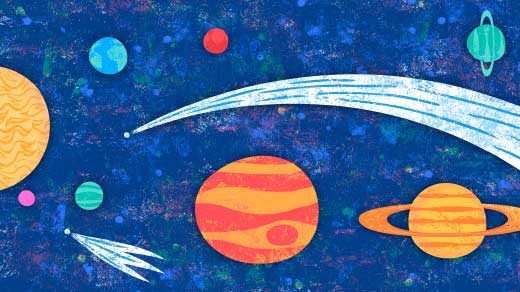Table of Contents
POEMS
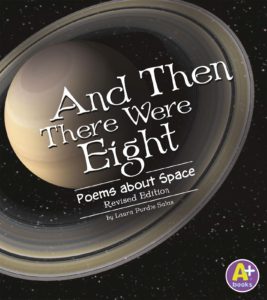 |
Laura Purdie Salas’s And Then There Were Eight (A+ Books, 2008) combines 15 poems about astronomy and space exploration with gorgeous color photographs. For ages 4-8. |
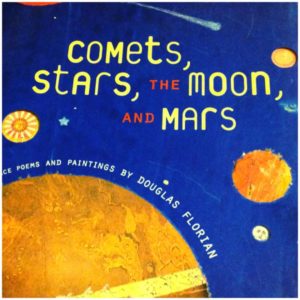 |
Douglas Florian’s Comets, Stars, the Moon and Mars (Harcourt Children’s Books, 2007) is an illustrated collection of catchy space poems for ages 5 and up. |
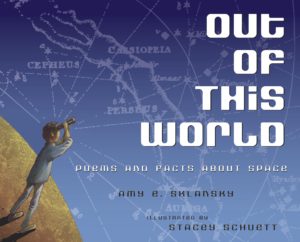
|
Amy Sklansky’s Out of This World (Knopf Books for Young Readers, 2012) is a clever collection of 20 illustrated poems about space travel and astronomy, with general information and cool factoids presented in sidebars. A great pick for ages 5 and up. |
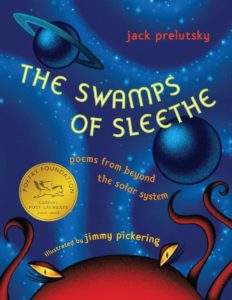 |
Jack Prelutsky’s The Swamps of Sleethe (Knopf Books for Young Readers, 2009) – subtitled “Poems From Beyond the Solar System” – is a fun but creepy collection about aliens that you really don’t want to meet. For kids who like a touch of the scary. For ages 6-9. |
| Walt Whitman’s When I Heard the Learn’d Astronomer is not a plug for science. Go on. Discuss. | |
| This collection of 10 Best Poems About Stars and Planets includes selections by Robert Frost, Emily Dickinson, and Carl Sandburg. | |
| Alan Shapiro’s Astronomy Lesson begins with two boys on the front porch, looking up. |
AND SOME SCIENCE FICTION
| From the Astronomical Society of the Pacific, Science Fiction Stories with Good Astronomy is a terrific (and long) categorized list. | |
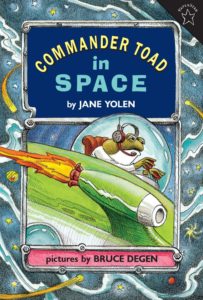 |
Jane Yolen’s Commander Toad in Space (Puffin, 1996) is the first of a series starring the “bold and bright” Commander Toad and his crew on the spaceship Star Warts. For ages 4-8. |
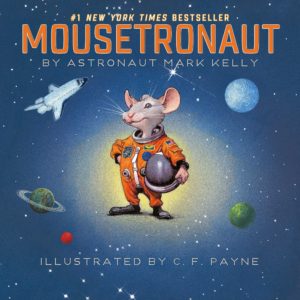 |
Mark Kelly’s Mousetronaut (Paula Wiseman Books, 2012) (“based on a (partially) true story”) features Meteor, a very small mouse, who saves a mission on the space shuttle Endeavor. Includes a lot of helpful info about daily life on the space shuttle. For ages 4-8. |
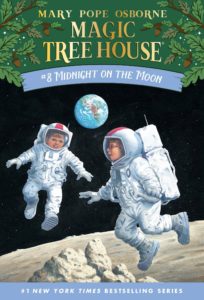 |
In Mary Pope Osborne’s Midnight on the Moon (Random House, 1996), one of the popular Magic Tree House series, Jack and Annie go forward in time and end up at the International Space Station on the moon. For ages 6-9. |
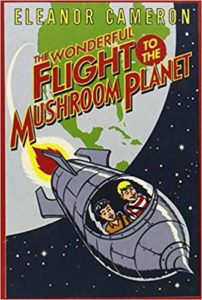 |
In Eleanor Cameron’s The Wonderful Flight to the Mushroom Planet (Little, Brown, 1988), Chuck and David build a homemade space ship and head off in it with odd little scientist Mr. Bass to the green planet of Basidium. For ages 8-11. |
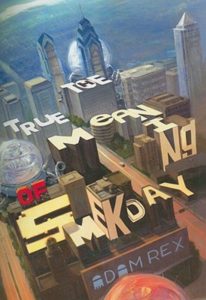 |
In Adam Rex’s funny and delightful The True Meaning of Smekday, aliens known as the Boov have taken over the Earth and forced all humans to relocate to Florida. Eleven-year-old Tip Tucci and a renegade Boov end up on a wild cross-country trip trying to find Tip’s mother and, incidentally, to save the world. A riotous read for ages 8-12. |
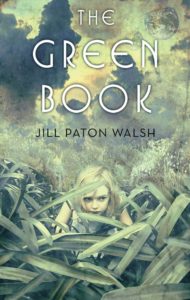 |
In Jill Paton Walsh’s The Green Book (Square Fish, 2012), Pattie and family have left the dying Earth to settle on the new planet of Shine – though on this beautiful crystalline planet it soon becomes clear that they may not be able to survive. (Readers learn on page one that colonists are only allowed to take one book per passenger – a tough decision.) For ages 8-12. |
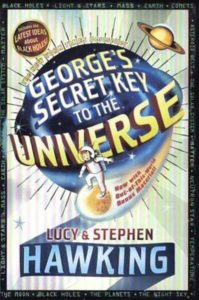 |
By Stephen Hawking – yes, the Stephen Hawking – and his daughter Lucy, George’s Secret Key to the Universe (Simon & Schuster, 2009), sends George traveling through space with the scientist next door, his daughter Annie, and a super-computer named Cosmos. There’s a lot of good science here – readers, for example, learn a lot about black holes – but the text can be labored. (“Why, George, science is a wonderful and fascinating subject that helps us understand the world around us.”) For ages 8-12. |
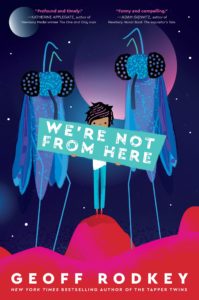 |
In Geoff Rodkey’s We’re Not From Here (Crown, 2019), Earth is uninhabitable; and Mars doesn’t readily support human life – so the human race, en masse, heads out to Planet Choom, world of the Zhuri, who look like giant mosquitoes, the marshmallow-like Ororo, the Krik (green werewolves), and the Nug (giant worms). By the time the human ships arrive, however, the government of Choom has changed its mind about accepting refugees – and Lan Mifune and family are picked as a test case, tasked with proving that humans can assimilate and live in peace. It turns out that there’s a lot more to this than expected. For ages 9-12. |
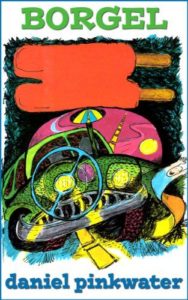 |
In Borgel (Aladdin, 1992), by the hysterically funny Daniel Pinkwater, young Marvin Spellbound is taken on an intergalactic road trip by his Uncle Borgel in search of the elusive Giant Popsicle. Uncle Borgel – who travels with 32 small black suitcases – turns out to be 111 years old and an experienced time-and-space traveler. For ages 9-12. |
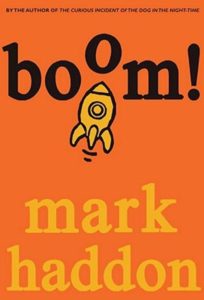 |
In Mark Haddon’s Boom! (Yearling, 2011) best friends Jimbo and Charlie overhear two of their teachers talking in a strange language and – curious – decide to investigate. It turns out that they’re aliens, kidnapping science-fiction fans to repopulate their dying planet. For ages 9-12. |
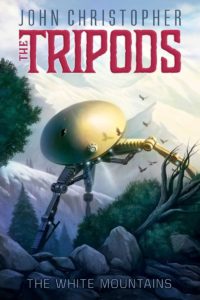 |
In John Christopher’s The White Mountains (Aladdin, 2014), the Tripods – giant alien machines – have taken over the Earth. Young Will Parker – about to turn 13 and due to undergo the Capping ceremony that will put him under the Tripods’ control – instead runs away to the White Mountains, hoping to join the anti-Tripod rebels. For ages 9 and up. |
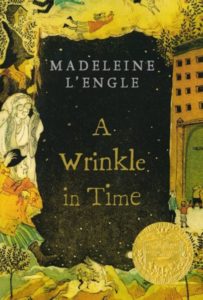 |
In Madeline L’Engle’s A Wrinkle in Time (Square Fish, 2007), originally published in 1962, Meg Murry, along with her five-year-old genius brother Charles Wallace and friend Calvin, are transported across the universe with the help of the mysterious Mrs. Whatsit, Mrs. Which, and Mrs. Who (and a tesseract) to find Meg’s lost scientist father. For ages 10 and up. |
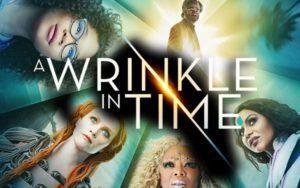 |
Also see the film version of A Wrinkle in Time (2018). Rated PG. |
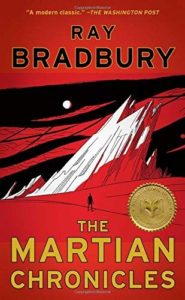 |
Ray Bradbury’s classic The Martian Chronicles (Simon & Schuster, 2012) is a collection of short stories about the colonization of Mars. Titles include “Rocket Summer,” “The Settlers,” “The Old Ones,” “The Silent Towns,” and “The Million-Year Picnic.” A wonderful read for ages 12 and up. |
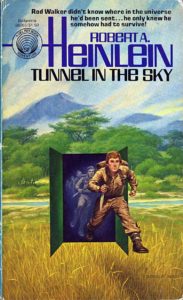 |
In Robert Heinlein’s Tunnel in the Sky (Pocket Books, 2005), Rod Walker, who wants to be a professional space colonist guide, is sent to a distant planet with other members of his high-school class for a short survival test. Something, however, goes terribly wrong and the kids are stranded. For ages 12 and up. |
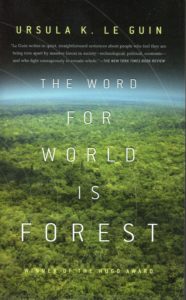 |
In Ursula LeGuin’s The Word for World is Forest (Tor, 2010), the peaceful forest planet of Athshe has been colonized by yumans – us – who are exploiting the “primitive” green-furred natives. Talk about metaphors. A good discussion book for ages 13 and up. |
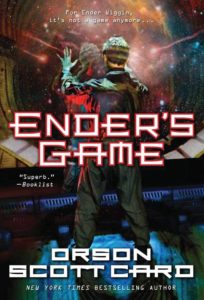 |
In Orson Scott Card’s Ender’s Game (Tor, 1994), the government is training child geniuses as soldiers to combat a hostile alien race. For ages 13 and up. |
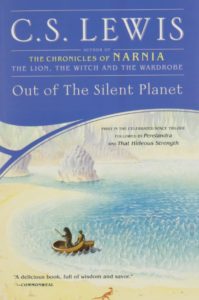 |
In C.S. Lewis’s Out of the Silent Planet (Scribner, 2003), Dr. Ransom is kidnapped by scientists Weston and Devine and taken to Malacandra (Mars), where they plan to turn him over to the sorns – the Malacandran natives – as a sacrifice. Along with the two sequels, Perelandra and That Hideous Strength, these are not only exciting science fiction adventures, but raise issues of theology and ethics. For ages 13 and up. |
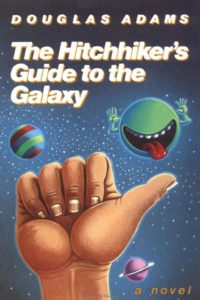 |
In Douglas Adams’s irresistible The Hitchhiker’s Guide to the Galaxy (Del Ray, 1995), Arthur Dent is yanked off Earth by his friend Ford Prefect – who is really an alien – seconds before the planet is demolished to make way for an intergalactic freeway. Always remember: (1) a towel is the most useful thing a space traveler can carry and (2) Don’t panic. For ages 13 and up. |
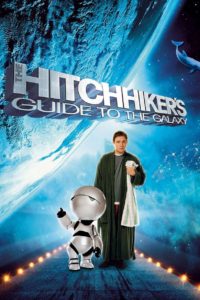 |
Also see the film version (2005), starring Martin Freeman as Arthur Dent. Rated PG. |
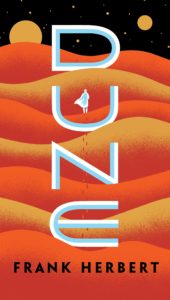 |
Frank Herbert’s Dune (Ace, 1990) – set on the desert planet of Arrakis – is the story of Paul Atreides who joins the desert-dwelling Fremen and becomes the legendary leader Muad’Dib. The book is a rich combination of politics, environmentalism, and religion, with giant sand worms. For ages 13 and up. |
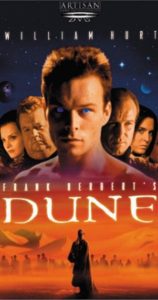 |
Dune was produced as a three-part mini-series in 2000. Not rated. |
